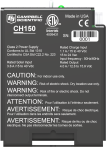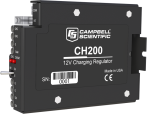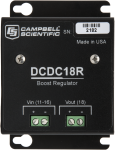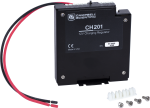This product is no longer available and has been replaced by: CH150.
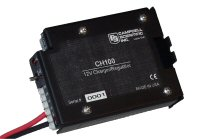
| 利用できるサービス | |
|---|---|
| 修理 | 非対応 |
| キャリブレーション | 非対応 |
| フリーサポート | 非対応 |
概要
The CH100 is a charging regulator for 12-V rechargeable batteries. This regulator provides built-in temperature compensation to optimize battery performance. It is commonly used when a rechargeable battery is required for the application and the PS150 or PS12LA power supply (7 Ahr) does not contain enough reserve amp-hours for the power supply budget.
続きを読むイメージ










CAD ファイル:
詳細
The CH100 regulator connects the BP12, BP24, or other sealed rechargeable battery to an external charging source (e.g., solar panel, wall charger). The circuitry of the CH100 is similar to the PS100, but the CH100 does not include a rechargeable battery. The rechargeable battery must be capable of accepting recharge from a trickle-charge source.
The CH100 controls the current flowing to the battery and prevents the battery current from flowing to the charging source.
仕様
| input Voltage (CHG Terminals) | 15 to 28 Vdc or 18 Vac RMS |
| Charging Output Voltage | Temperature-compensated float charge (for 12 Vdc battery) |
| Charging Current Limit | 1.2 A (typical) |
| Power Out (+12 Terminals) Voltage | Unregulated 12 Vdc from battery |
| Length of Red and Black Wires | ~30 cm (12 in.) |
| Dimensions | 10.2 x 7.0 x 3.9 cm (4.0 x 2.8 x 1.5 in.) |
| Weight | 158 g (5.5 oz) |
Quiescent Current |
|
| Charge Source Present | 3 to 5 mA |
| No Charge Source Present | 0 mA |
よくある質問
CH100に関するよくある質問の数: 15
すべて展開すべて折りたたむ
-
Actually, the current flows up to the maximum amount of amperage based on whether the battery will take the charge or not. The internal resistance of a lead-acid battery increases as it reaches a full charge. The charger/regulator must perform two operations when charging a battery:
- Give the battery all the current it will take when it is in a discharged state.
- Limit the voltage across the battery to a set value based on temperature when the battery reaches a full charge so as not to overcharge the battery.
The voltage rises as the voltage in the battery rises. When the battery voltage rises up close to the voltage limit of the charger, the voltage of the regulator is limited. This causes the battery to take less and less charge (less amperage) because the voltage of the battery and the regulator get to be so close that no more current can be forced into the battery.
-
The CH100 has a built-in diode that only allows battery current to flow out of the battery to the 12 V and G terminals. But, because both loads are hooked up to the same battery, the system still drains the same. If there are two loads, and one is of a lesser priority than the other, the lower priority load can be controlled by connecting it to the SW12 on the data logger and turning it off if the battery voltage starts to get too low.
-
いいえ。CH100 は 24 Vdc バッテリ パックではなく、12 Vdc バッテリ パックを充電するように設計されています。
-
A better alternative is to purchase pn 17200, Battery Power Cable, 7 inches, or pn 22024, Battery Cable. Both cables include the plug that connects to the following regulators: CH100, CH200, PS100, and PS200. Using one of these cables ensures that the battery voltage is correct. This is because of the voltage drop across a diode that is between the battery terminals and the 12 V load terminals.
-
BP24 は、レギュレータの無いソーラー パネルに直接接続しないでください。回路には必ず CH100 などの電圧レギュレータを含めてください。そうしないと、バッテリが損傷します。
-
With a solar panel connected, the quiescent current should be less than a 3 mA draw on the solar panel to light up the LED. (It does not consume current from the battery.) At night, the blocking diode blocks all measurable current from the battery. For power budget calculations, use 0 mA for the CH100 or PS100.
-
The PS100 (and CH100) are limited to 1.2 A of input. Because the SP20 20 W solar panel generates 1.17 A, that single panel represents a practical limitation to the input. For panels that generate current greater than 1.2 A, consider the PS200, Smart Power Supply and Charge Controller, or CH200, Smart 12 V Charging Regulator, for up to 3 A of input, or pn 18529, 10 A, 12 V, Morningstar Regulator, which is capable of accepting 10 A of input.
Generally, it is not recommended to connect more than one panel at a time. Differential shading can cause issues, such as the shaded panel acting as a current sink.
-
正確にはそうではありません。PS24 は、24 Ah バッテリ、CH100 レギュレータ、 10 x 12 インチの屋外収納ケースで構成されています。屋外収納ケースを除けば、PS24 は CH100 と組み合わせた BP24 と非常によく似ています。
-
The red LED light on the CH100 or PS100 comes on whenever there is a working charging source connected. For example, if a solar panel is connected to the device, and the sun is shining, the LED light will turn on until the sun starts to go down. The red LED light should always be on when the device is connected to the wall transformer (when the ac power is present). Thus, the LED light is only a confirmation of power available to charge the battery.
If it is desirable to have an indication that the power switch is on, an LED light can be added to an unused control port on the data logger and a program can be written to cause the LED light to blink every few seconds. Blinking the LED light once every few seconds will not put a large load on the battery, whereas a continuously lit LED draws down the battery more quickly.
-
CH100 充電コントローラは、メンテナンスフリーのディープサイクル鉛蓄電池で動作するように設計されています。充電器の電圧は、船舶用液浸型バッテリの充電に必要な電圧とは若干異なります。そのため、Campbell Scientific では、液浸型バッテリではなく、BP12 や BP24 などのディープサイクル バッテリの購入を推奨しています。SP20R や SP10R などの当社の規制対象ソーラー パネルは、ユーザーが提供する液浸型バッテリと一緒に使用し、直接接続することを目的としています。
ケーススタディ
2013 年、ルイジアナ州南部の歴史的な家屋の隣に陥没穴が出現しました。その後数か月で、陥没穴は深さ 30.5 メートル (100 フィート)、幅 61 メートル (200 フィート) にまで拡大しました。RESPEC は、不安定になる可能性のある斜面を監視するために、2014 年初頭に堅牢な伸縮計システムを設計、製造、設置しました。RESPEC は、システムのバックボーンとして、Campbell Scientific......続きを読む
現在、アンデスの熱帯氷河は急いで後退しています。 これらの氷河は、ペルー南部の乾燥した冬と干ばつの間、恒久的な水源であると考えられています。手前にいるため、この状況は注目を集めています。 コロプナはペルー最大かつ最も高い火山で、リマの南1,000 km (620 マイル) のアレキパにあります。 最高標高は 6,400 m (21,000 フィート) で、ペルーで約 3 番目に高い地点であり、年間降水量が......続きを読む
記事とプレスリリース
以下に記載
Privacy Policy Update
We've updated our privacy policy. 詳細はこちら
Cookie Consent
Update your cookie preferences. クッキーの設定を更新する
